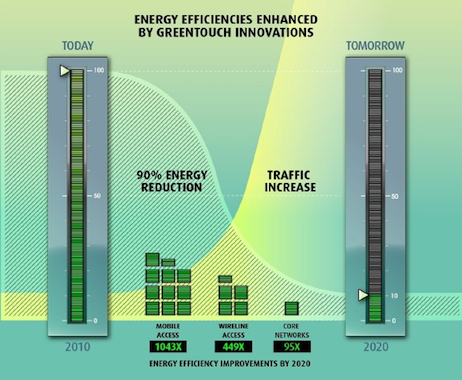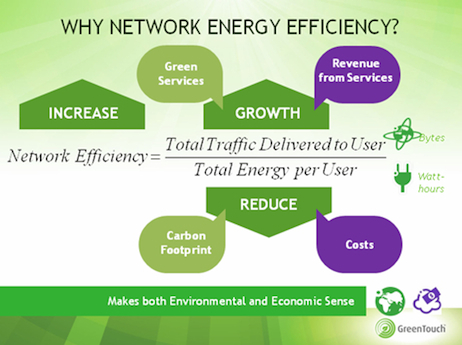Telcos to Slash Energy Use 90 Percent by 2020
Energy consumption is not a one company problem – it is an end-to-end problem.
– GreenTouch
 While the ICT industry has transformed the way we work and play with inventions like the smart phone, the field is also contributing to a growing environmental problem. According to GreenTouch board member and director of the University of Melbourne's Centre for Energy-Efficient Telecommunications, Dr. Rod Tucker, the ICT ecosystem accounts for about 2 percent of the world's carbon emissions, roughly equivalent to that produced by the aviation industry or 50 million automobiles.
While the ICT industry has transformed the way we work and play with inventions like the smart phone, the field is also contributing to a growing environmental problem. According to GreenTouch board member and director of the University of Melbourne's Centre for Energy-Efficient Telecommunications, Dr. Rod Tucker, the ICT ecosystem accounts for about 2 percent of the world's carbon emissions, roughly equivalent to that produced by the aviation industry or 50 million automobiles.
Launched three years ago, GreenTouch is a global research consortium dedicated to dramatically improving the energy efficiency of data and communications networks. Despite exponentially-increasing network traffic, the group asserts that it is possible to reduce energy consumption 90 percent by 2020. These findings were revealed earlier this week as part of the consortium's first Green Meter research study.
First, a little background information. This latest announcement is actually part of an even more ambitious goal set by GreenTouch in 2010: improving the energy efficiency of networks by a factor of one-thousand.
"We are talking about reinventing the Internet which requires world-wide collaboration," states GreenTouch member Nicolas Demassieux in a video.
The depth and breadth of this undertaking are beyond the scope of one single company, and this is precisely why GreenTouch was founded – with the understanding that collaboration and open innovation are accelerants to progress.
The research consortium comprises key stakeholders from the IT industry, including equipment providers, operators, research institutions and academia. Starting with just a handful of founders in 2010, the group now counts more than 50 members, including such well-known outfits as Bell Labs, CalTech, Fujitsu, Huawei, INRIA, KAIST, Samsung and many more.
A challenge of this size means that new technologies will need to be invented and current technologies will need to be optimized. A big part of GreenTouch's strategy is building a theoretical framework to investigate the energy reduction potential of the different approaches. It was such a modeling framework that led to this week's announcement, revealed in a webcast by Thierry Klein, GreenTouch's technical committee chair and head of Bell Labs green research.
On the agenda is the outcome of the consortium's first Green Meter research study, conducted over the last nine months. The group members wanted to assess the overall energy impact of all the ideas, technologies, architecture, algorithms and protocols they had been investigating. They also sought to understand which technologies would have the greatest impact, so that they could allocate their resources accordingly.

The modeling study evaluated an energy-efficient 2010 network with a future hypothetical 2020 scenario. "We looked at network traffic in 2010 and focused on technologies that were the best, most efficient, commercially-available technologies in 2010 and calculated the energy-efficiency and the energy-consumption of that network in 2010," says Klein.
"Then we took the set of technologies and ideas and protocols that were the most energy efficient and built a 2020 model using expected network traffic volumes and applied these technologies to calculate the corresponding energy efficiency and consumption and then compared these two numbers. When we did that, we realized that it's possible to reduce the net energy consumption by up to 90 percent between these two [models]."
Net energy consumption, according to Klein, means the energy communication in network going into 2020 while accounting for traffic growth in the network. Traffic is indeed growing so it's important to analyze the impact of this growth and understand how the technologies can accommodate it in a more sustainable way, he states.
Klein explains the findings provide a roadmap for service providers with identified architectures, prototypes and technology for improving the energy-efficiency of networks. For the consortium, it also serves as a progress report, an assessment of where the group stands with regard to its overarching goal of achieving a thousand-fold greener network.

GreenTouch defines network efficiency as the ratio of the traffic load divided by the energy that it takes to support that traffic.
"If you can reduce the energy consumption in network by 90 percent that means you can support all the traffic, all the applications, all the services that we want to enjoy as consumers and enterprises, and the operators and service providers will be able to handle that while reducing the net energy consumption, while reducing the operating expense and while reducing carbon footprint, while still supporting the growth in traffic," Klein comments.
Applying the 90 percent figure number to all mobile services in the US, the absolute energy that could be saved would be roughly equivalent to the amount of energy used by a city like Dallas, Texas, with a population of one million, over the course of the year. In terms of carbon emissions, this is equivalent to removing 2 million cars from the road, saving 24 million barrels of oil.
The study identified mobile networks, currently very inefficient, as having the biggest opportunity for improvement. They are on track to becoming 1,043 times more energy-efficient by 2020 if the recommended technologies are adopted, according to the GreenTouch model.
The anticipated improvements for fixed-line and core networks are not nearly as dramatic. According to the 2020 model, fixed access networks show a 449x improvement, while the core network demonstrates a more modest gain of 95x.
At three years old the consortium is two-thirds of the way into its five-year mission of developing cutting-edge sustainable technologies. With 16 projects underway, including the Large Scale Antenna System and Bi-PON (bit interleaving passive optical network), the 53 partner members are working to support network growth in a manner that is both economically and environmentally sound.
"We are extremely proud of the progress we've made in our first three years, yet there is still much more we can do to improve efficiencies and effectively reinvent technologies in the name of environmental stewardship," states Thierry Van Landegem, chairman, GreenTouch. "Reducing energy by 90 percent is conservative as we have many projects underway whose effects were not taken into account in that number."
As one GreenTouch member, Dr. Chih Lin, puts it:
"We need to set aggressive goals because the future has to be green and anything that is not green doesn't belong in the future."










